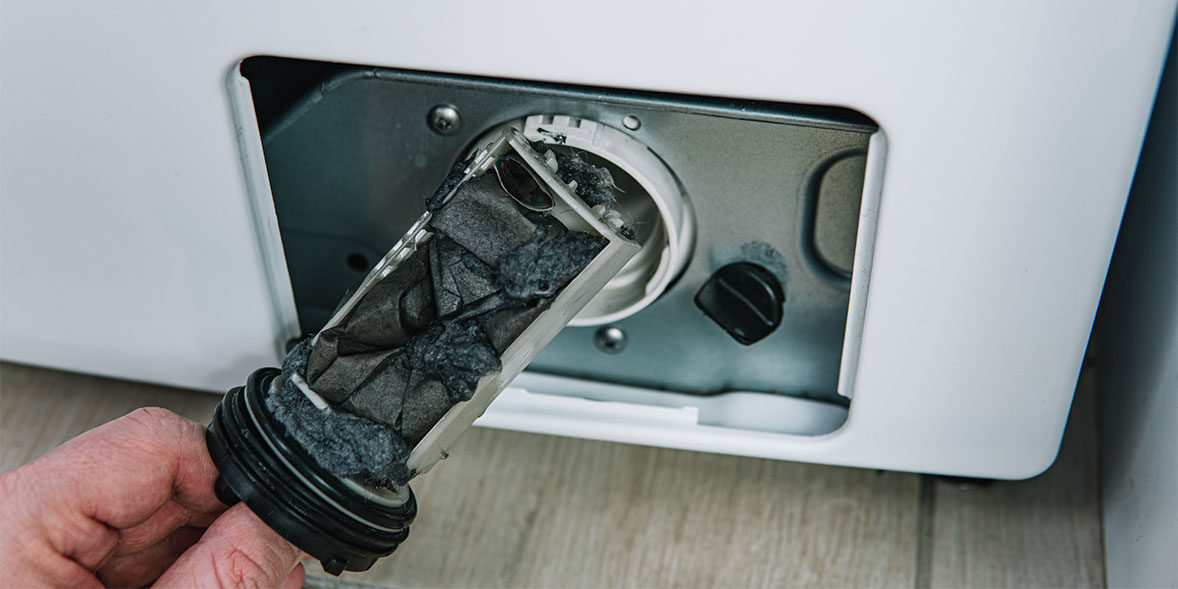Why dirty filters cost you more and could break your appliance

Regular maintenance and deep cleans can make a big difference to the lifespan of your appliances. Our exhaustive lab tests also show it can help reduce your energy use and save money in the long run.
To make sure your home appliances run as cheaply and efficiently as possible, we've compiled our top tips on the best ways to clean the filters on appliances including your cooker hood, washing machine, vacuum cleaner, tumble dryer and more.
Keep reading for a step-by-step guide to checking and cleaning your filters.
Get our expert tips for making smarter consumer choices. Sign up for our free Weekly Scoop newsletter
1. Cooker hood filter

Over time, cooker hoods get clogged up with grease, food splashes and other dirt. This prevents them from circulating clean air effectively, which is why manufacturers recommend you clean the metal filters (or replace disposable filters) every two months.
The best way to clean your cooker hoods is to remove them from the cooker hood and soak them in hot soapy water. If needed, use a brush to dislodge the grease that’s collected in the gaps. The metal filters can also be washed in the dishwasher, but keep them clear of any dishes.
You must let the filters air dry completely before placing them back in the cooker hood.
We've reviewed cooker hoods costing from £50 up to £1,500. To see which impressed in our tough lab tests, discover our best cooker hoods
2. Washing machine filter

A build-up of debris in the filter will make your washing machine less efficient. If the drum is unable to drain, your clothes might come out wet and need a longer cycle to spin, which will also use up more energy.
To prevent this we would recommend cleaning your filter thoroughly every six to eight weeks.
To clean your filter, first disconnect the machine from the power and turn off the water supply. Lay a towel and a tray on the floor and remove the access cover, take the cap off the hose and let the water drain into the tray. After all the water is drained, put the hose back into position.
Finally, unscrew the filter, remove any debris and clean it with warm water before screwing it back on. Make sure the filter is properly and firmly screwed on to avoid accidental flooding the next time you use your washing machine.
In our latest large appliance reliability survey*, we asked washing machine owners how often they did this – 19% said once a month, but the same proportion said they never performed this task.
Check out our guide to common washing machine problems and how to fix them. Or, if it's time for a new one, discover the best washing machines.
3. Vacuum cleaner filter

If your vacuum cleaner makes a lot of noise but struggles to pick up dirt and debris, you might have a blocked filter. This can cause a big drop in suction and make it far less efficient.
You can help avoid this by cleaning the filter once a month. Methods vary and depend on the type of vacuum cleaner you own, but best practice generally is to remove the filter, tap or brush away any excess dust and run it under cold water.
Leave it to air dry before putting it back into the machine – manufacturers recommend waiting 24 hours or until you're sure it’s completely dry.
In our most recent large appliance reliability survey*, around 30% of respondents said they perform this task monthly, and between 17-18% said they do it every three months.
Is your vacuum cleaner still struggling to pick up dirt? Discover how to fix a vacuum cleaner that's lost suction. If it's time for a new model, head straight to the best vacuum cleaners
4. Tumble dryer filter

There are many reasons why you should be cleaning your tumble dryer lint filter regularly. Not only is it a potential fire hazard, but a build-up of fluff can mean longer drying cycles and therefore higher energy bills.
If possible, get in the habit of cleaning the filter after every cycle. All you need to do is simply remove the lint and accrued debris before putting it back into the dryer.
In our most recent large appliance reliability survey*, 54% of respondents said they did this after every use, whereas 15% said they did it weekly, and 10% monthly. Just 3% said they had never done this.
On condenser dryers, the condenser unit (found below the drum) will also get clogged with hair and fluff, so every month this unit will need to be removed, cleaned and rinsed, and put back into the machine.
With heat pump dryers, our tests show that failing to clean the lower filter can result in longer drying times, steamier windows and mounting energy costs. It’s a relatively quick and straightforward job, but refer to the manual for advice from the manufacturer about how to do this and how often.
For further advice on cleaning the filters and prolonging the life of your dryer, visit our tumble dryer tips and maintenance guide. If it's time for a new appliance, discover the best tumble dryers
5. Dishwasher filter

Dishwasher not working properly or starting to smell bad? Chances are you might need to clean the filter.
The filter is usually found at the base of your machine below the spray arms. It’s often easier to access it by removing the bottom rack of the dishwasher and setting it aside.
The easiest way to remove the filter is to simply twist and pull. Take this opportunity to wipe away any debris from the bottom of the machine with a soft, damp cloth as well.
Then, you need to rinse the outer casing of the filter with hot water to get rid of any dirt and food debris. Use a soft brush to help you access the harder-to-reach parts of the inner filter.
Once you're happy that it's clean, put it back in place the same way that you removed it and replace the lower basket.
It's recommended that you clean your dishwasher filter once or twice a month. According to our latest large appliance survey*, 31% of people undertake this task monthly, while 15% claim to do it every week, and 15% do it every three months.
For further advice, read how to clean a dishwasher. Or, if it's time for an upgrade, discover our expert pick of the best dishwashers
6. Dehumidifier filter

To efficiently draw moisture out of the air they suck in, dehumidifiers will have a filter to keep out any dust. Manufacturers say that this filter getting blocked is a common reason for dehumidifiers not working properly.
Cleaning the filter should be easy, and the instruction manual, or the manufacturer's website, should have instructions on how to do so.
In most cases, you simply unplug your machine, find and remove the filter, and vacuum off any dust that has accumulated with a handheld vacuum or attachment brush.
Our expert says

Dehumidifiers have a very basic dust filter that keeps the coils/desiccant wheel from getting clogged up. It doesn't need replacing, just vacuuming occasionally, and many models will have a filter warning for when it's clogged. If it's not cleaned, the dehumidifier won't be able to draw in as much air, so will take longer to do its job, and you'll have to run it for longer to achieve the same results.
We have more maintenance tips, as well as Best Buys and buying advice, in our guide to the best dehumidifiers
7. Air purifier filter

While some air purifiers are noisy because of their general design, others may get noisier if the filter becomes clogged with dust or dust builds up on the ioniser pins (which, put very simply, create static for dust particles to stick to).
It might be worth checking if you can vacuum some of the dust out of the filter to prevent this from happening.
Some air purifiers have a 'change filter' beep that will warn you when the filter needs cleaning or replacing. Typically, the filters in air purifiers need to be replaced every 6-12 months.
Find out more about air purifier filters, prices, and the features to look for in our guide to the best air purifiers
*In our latest large appliance reliability survey, we asked more than 10,200 people to tell us about their appliances. Online survey of 4,514 Which? Connect panel members and 5,735 members of the public, conducted online in July 2024.





